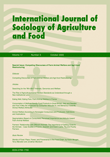Social Capital as a Success Factor for Collective Farmers Marketing Initiatives
##plugins.themes.bootstrap3.article.main##
##plugins.themes.bootstrap3.article.sidebar##
Abstract
This study aims at uncovering how social capital at micro and macro levels contributes to the success of farmers’ co-operation and how imbalances between the different forms of social capital can hamper collective action among farmers. Using a case-study approach, we analyse two collective farmers marketing initiatives from Austria and Hungary, which have emerged in very diverse political and social environments and followed different development paths. Differences in the performance of these organizations can be partly traced back to variations in the contextual environment. However, the empirical data suggest that social capital plays an important role as well, since it is crucial for mobilizing the initial set of different forms of other capitals like natural, physical, financial and human capitals. The aim of this article is to understand the dynamics and impacts of different configurations of social capital and its contribution to the economic success of collective initiatives. Based on the empirical findings collective farmers marketing initiatives can deduct ways to consciously appraise and invest in social capital.
How to Cite
##plugins.themes.bootstrap3.article.details##
Bodorkós, B. and Kelemen, E. (2007) Re-establishing a Co-operative in a Disadvantageous Region of Hungary: Social Capital, Action Research and the Role of Researchers. Draft paper for the XXII. ESRS Conference, Wageningen, Netherlands, 20–24 August.
Cas tle, E.N. (2002) Social capital: an interdisciplinary concept, Rural Sociology, 67(3), pp. 331–349.
Chloupk ova, J., Svendsen, G.L.H. and Svendsen, G.T. (2003) Building and destroying social capital: the case of cooperative movements in Denmark and Poland, Agriculture and Human Values, 20, pp. 241–252.
Csurgó, B., Kelemen, E., Kovách, I. and Megyesi , B. (2007) National Synthesis Report on Case Studies in Hungary, COFAMI-project. Published online
Gittell, R.J. and Vidal, A. (1998) Community Organizing: Building Social Capital as a Development Strategy, Thousand Oaks, CA: Sage Publications.
Goodwin, M. (2003) Five Kinds of Capital: Useful Concepts for Sustainable Development, Global Development and Environment Institute Working Paper No. 03-07. Published online
Granovetter, M. (1985) Economic action and social structure: the problem of embeddedness, American Journal of Sociology, 91(3), pp. 481–510.
Falk, I. and KilpaPAtrick , S. (2000) What is social capital? A study of interaction in a rural community, Sociologia Ruralis, 40(1), pp. 87–109.
Hoff erth, S.L. and Iceland, J. (1998) Social capital in rural and urban communities, Rural Sociology, 63, pp. 574–598.
Kluvánková-Orávsk á, T. and Chobotová, V. (2006) Shifting Governance in Slovensky Raj National Park, ICAR discussion paper 15/2006. Bratislava: Institute for Forecasting, Slovak Academy of Sciences.
Leonard, M. (2004) Bonding and bridging social capital: reflections from Belfast, Sociology, 38(5), pp. 927–944.
Lin, N. (2001) Social Capital: A Theory of Social Structure and Action. Cambridge: Cambridge University Press.
Péterfi , F. (2008) A Közbizalom és a Részvétel Helyzete Magyarországon 2008 Öszén. Budapest: Közösségfejleszt?k Egyesülete, published online
Polányi, K. (1944) The Great Transformation: The Political and Economic Origins of our Time. Boston, MA: Beacon Press.
Portes, A. (1998) Social capital: its origins and applications in modern sociology, Annual Review of Sociology, 24, pp. 1–24.
Portes, A. (2000) The two meanings of social capital, Sociological Forum, 15(1), pp. 1–12.
Portes, A. and Sensenbrenner, J. (1993) Embeddedness and immigration: notes on the social determinants of economic action, American Journal of Sociology, 98, pp. 1320–1350.
Putnam, R.D. (2000) Bowling Alone: The Collapse and Revival of American Community. New York: Simon & Schuster.
Rydin, Y. and Holman, N. (2004) Re-evaluating the contribution of social capital in achieving sustainable development, Local Environment, 9(2), pp. 117–133.
Schaff t, K.A. and Brown, D.L. (2003) Social capital, social networks, and social power, Social Epistemology, 17(4), pp. 329–342.
Schermer, M. and Rieder, E. (2007) National Synthesis Report on Case Studies in Austria, COFAMI-project. Published online
Svendsen, G.L.H. (2006) Studying social capital in situ: a qualitative approach, Theory and Society, 35, pp. 39–70.
Svendsen, G.L.H. and Svendsen, G.T. (2000) Measuring social capital: the danish co-operative dairy movement, Sociologia Ruralis, 40(1), pp. 72–86.
Szreter, S. and Woolcock , M. (2004) Health by association? Social capital, social theory, and the political economy of public health, International Journal of Epidemiology, 33, pp. 650–667.
Uphoff , N. and Wija yaratna, C.M. (2000) Demonstrated benefits from social capital: the productivity of farmer organizations in Gal Oya, Sri Lanka, World Development, 28(11), pp. 1875–1890.
Van Deth, J.W. (2003) Measuring social capital: orthodoxies and continuing controversies, International Journal of Social Research Methodology, 6(1), pp. 79–92.
Woolcock , M. (1998) Social capital and economic development: toward a theoretical synthesis and policy framework, Theory and Society, 27, pp. 151–208.
Woolcock , M. (2001) The place of social capital in understanding social and economic outcomes, Canadian Journal of Policy Research, 2(1), pp. 1–17.
Woolcock , M. and Narayan, D. (2000) Social capital: implications for development theory, research, and policy, World Bank Research Observer, 15(2), pp. 225–249, published online
CC BY 4.0 https://creativecommons.org/licenses/by/2.0/
You are free to:
Share — copy and redistribute the material in any medium or format
Adapt — remix, transform, and build upon the material for any purpose, even commercially.
This license is acceptable for Free Cultural Works.
The licensor cannot revoke these freedoms as long as you follow the license terms.
Under the following terms:
Attribution — You must give appropriate credit, provide a link to the license, and indicate if changes were made. You may do so in any reasonable manner, but not in any way that suggests the licensor endorses you or your use.
No additional restrictions — You may not apply legal terms or technological measures that legally restrict others from doing anything the license permits.
